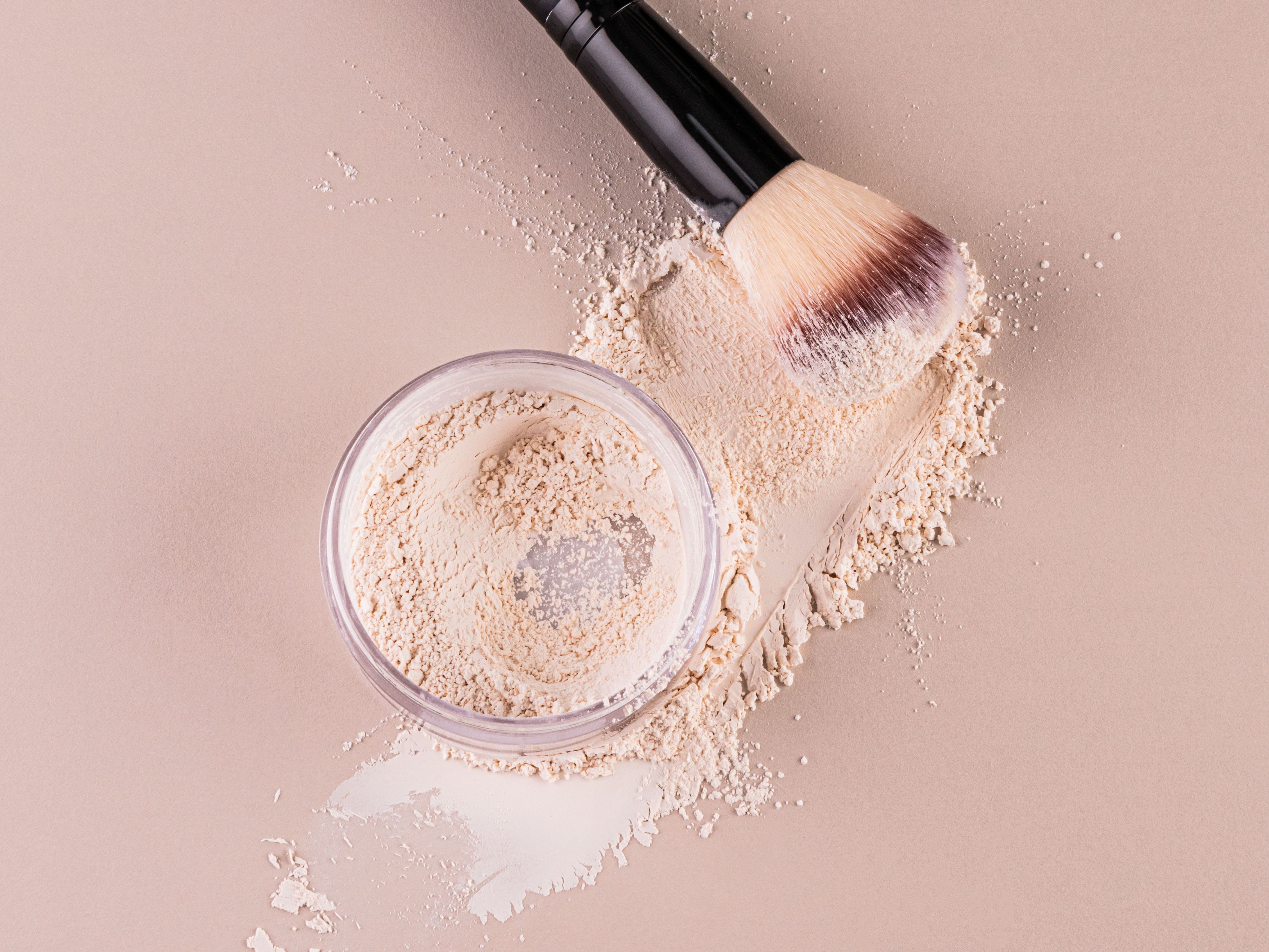Cosmetic Powders: On the Face of It

The Bottom Line
Face makeup is loose or pressed powder containing silica, talc, and other ingredients. Blush and bronzer contain pigments to make skin look flushed or tan. Face powders are usually safe but can be irritating for people with sensitive skin. Loose powder poses a risk of lung injury if inhaled.

What is in makeup powder?
Makeup powder is applied to the face to help makeup set, absorb moisture on oily skin, smooth out the skin, and conceal lines and blemishes. The 2 main types are loose powder and pressed powder. Ingredients include silica, starch, talc, dimethicone, zirconium silicate, zinc oxide, titanium dioxide, kaolin, and magnesium carbohydrate.
Foundation that is liquid-based (for dry skin) or powder-based (for oily skin) is usually applied first. Blush and bronzer both add color. Blush gives cheeks a flushed look and bronzer provides a tanned look. Blush most often contains a red pigmented talcum-based powder while bronzer contains a mixture of pigments to give a tan appearance. Setting powder (containing talc or silica) is applied on top of foundation and concealer, but under blush and bronzer. It absorbs oil and locks makeup in place. Setting powder is best for oily skin. An alcohol-based setting spray is used on dry or combination skin.
Is makeup powder bad for the skin?
Makeup powder is generally considered safe for use on your skin. Regular use of talc-based powders can make your skin dry and flaky. Some people develop acne or find that their acne worsens when using face makeup. It is important to remove makeup at the end of each day and clean your skin.
What is talc? Is it dangerous?
Talc is a naturally occurring mineral composed of magnesium, silicon, oxygen, and hydrogen. It is found in many cosmetic products and is usually safe for the skin. Some people with sensitive skin can experience irritation, especially if used in the folds of the skin. Since talc and asbestos (a known carcinogen) are located near each other in the earth, there is potential for contamination of talc with asbestos. The Food and Drug Administration has tested talc-containing cosmetic products, and most recent tests from 2023 found no asbestos.
Is makeup powder safe for kids?
Makeup powder is usually non-toxic or minimally toxic if ingested by a child. Serious lung problems can occur if talcum powder is inhaled. For that reason, it is best to keep loose talc-based face powders away from children. Many baby powders now contain corn starch instead of talc.
I am having a negative reaction to makeup powder. What should I do?
Immediately stop using the makeup powder. Wash your face. Applying cold compresses and then moisturizers may help your face feel better. Avoid using similar products. If you are experiencing an allergic reaction, a steroid cream, such as non-prescription hydrocortisone, or oral antihistamine, such as diphenhydramine (Benadryl) or cetirizine (Zyrtec), may be indicated.
If someone is having a negative reaction to face makeup, gets face makeup in their eyes, swallows face makeup, or if you have a question about using face makeup safely, help from experts is available through the webPOISONCONTROL online tool and by phone at 1-800-222-1222. Poison Control’s expert guidance is always free, confidential, and available 24 hours a day.
Wendy Klein-Schwartz, Pharm.D., MPH
Clinical Toxicologist
Poison Control Media Information
Did you find this page helpful? If so, we need your support. Poison Control is in constant competition with misinformation online. Links to www.poison.org or our webPOISONCONTROL triage tool from other websites and blogs help internet searchers quickly find accurate information and Poison Control’s contact information in an emergency. If you use the content from this page, please provide attribution via a link back to this page, www.poison.org, or https://triage.webpoisoncontrol.org/#!/exclusions. By doing so, you could save a life. Thank you!
Poisoned?
Call 1-800-222-1222 or
Prevention Tips
- Store face makeup up, away, and out of sight of children.
- Clean your face and hands before applying makeup.
- Clean brushes regularly.
- Apply moisturizer to keep your skin from getting dry.
- Store makeup in a cool dry place.
- Keep containers clean and covered.
- Don’t share face makeup.
- Don’t add anything to makeup.
- Check the expiration date and throw out if its expired.
This Really Happened
A 26-year-old woman switched from blush to bronzer for her face to look tan. Often, she does not remove her makeup until the next morning when she goes to re-apply it. She developed dry and flaky skin but continued using the product. She then experienced itching, redness and a rash on her face where she was applying the bronzer. She contacted POISONCONTROL and the specialist told her that she may be experiencing contact dermatitis from the bronzer. The specialist instructed her to stop using the bronzer, wash her face and apply moisturizer. If her condition persisted or worsened, she may need to apply a steroid cream. On follow-up the next day, she stated that she was better. She no longer had itching or rash although her skin was still dry and a little red. She was told to continue using moisturizer on her face.For More Information
Talc. FDA. April 5, 2024. https://www.fda.gov/cosmetics/cosmetic-ingredients/talc.
References
Paikray E, Bisoyi D, Rout A, Mishra V. Analysis and reporting adverse drug reaction of cosmetics at a tertiary care hospital. Cureus. 2014;16(3):e56856. doi: 10.7759/cureus.56856.
Patarino F, Norbedo S, Barbi E, Poli F, Fulan S, Savron F. Acute respiratory failure in a child after talc inhalation. Respiration. 2010;79(4):340. doi: 10.1159/000181013.
Toklu HZ, Antigua A, Lewis V, Reynolds M, Jones J. Cosmetovigilance: A review of the current literature. J Family Med Prim Care. 2019;8(5):1540-1545. doi: 10.4103/jfmpc.jfmpc_447_18.
Poisoned?
Call 1-800-222-1222 or
Prevention Tips
- Store face makeup up, away, and out of sight of children.
- Clean your face and hands before applying makeup.
- Clean brushes regularly.
- Apply moisturizer to keep your skin from getting dry.
- Store makeup in a cool dry place.
- Keep containers clean and covered.
- Don’t share face makeup.
- Don’t add anything to makeup.
- Check the expiration date and throw out if its expired.
